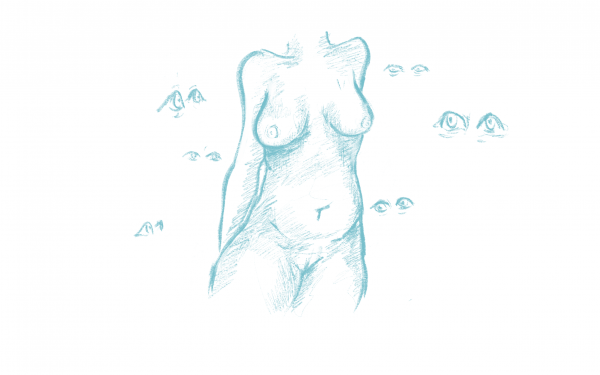Crafting fantasies in high heel boots
Is sex work art? Those who live it every day can provide some answers
Mistress Ayverie greets us in a silk robe at the entrance of her dungeon with a hug and, later, cups of mint tea.
A professional dominatrix, musician, hypnotist and bonafide sadist, Ayverie has set up a cozy space with cushions, candles and incense in a corner of her dungeon, where we sit and ask her what initially drew her to the career of a professional dominatrix.
“I knew you’d ask that. Of course,” she laughs, and launches into a description of her younger, naive former self with no BDSM background, who was intrigued by the concept of dominance.
Initially introduced to the scene when she joined a website for dating wealthy men, Ayverie was often asked by men on the site if she was “dominant.”
“I always immediately said yes without question. I didn't have to think about it,” Ayverie recalls. “But that got me thinking, obviously, ‘What do they mean by that?’”
From that point on, Ayverie began to explore how she could become a professional dominatrix.
“[Domination] was fun for me, but I had no idea what the ramifications were psychologically when delving into this play,” Ayverie says, describing what is known as “top space,” where the dominant gets a rush or high from the feeling of power.
“I could be dark, whereas in normal life that would be unacceptable, especially for a woman,” she says.
Ayverie began to fly back and forth between Montreal and New York to attend BDSM workshops. Shortly thereafter, she connected with a mentor in Los Angeles, where she enrolled in a dominatrix academy run by Mistress Damiana Chi, who holds a PhD in clinical psychology.
“I honestly thought it was going to be easy to become a dominatrix,” Ayverie says as she pours us tea from a little pot. “Couldn't be further from the truth. [...] It was like six months of intensive training, essentially.”
Ayverie describes the fluid and artistic nature of domination. When she first watched Chi embody the strong goddess energy of the dominatrix, Ayverie was almost brought to tears by the empowerment.
“It was so beautiful to see and so elegant and not really what I expected,” she says.

Now, after spending much time reading books and attending another dominatrix academy, this time in Montreal, Ayverie feels she is at the point where she gets to play freely with her own creative flavour as a dominatrix. As a musician and performer, she explores musicality in her sessions. She also plans to mix performative art and video art with her music and BDSM in the future.
Having studied clinical hypnotherapy, Ayverie also integrates BDSM as a powerful healing modality, with both erotic and general hypnosis being common kinks in the BDSM community.
“When you understand a submissive’s psychology, or even just a kinkster's psychology, it's really easy to break them,” she laughs.
BDSM is like adult playtime, according to Ayverie. Her dungeon, equipped with a plush black throne, a large cage and a row of floggers, paddles and whips, among other toys and equipment, is like a dark and kinky playground for those who are of legal age.
“[BDSM] is inherently creative because we are playing with fantasy, imagination and literal toys,” Ayverie says. “There are endless ways to be creative as a domme, especially because every play partner is different.”
For Ayverie, her work is performance art, but it's not performative in the sense that it feels like acting or role play―it's also real, raw and at times surreal.
“Essentially what you're doing as a dominatrix is you're creating this world,” she says. “It's like another dimension that [the sub] enters. [...] You slowly take away their old reality, their old self, like stripping it down layer by layer until they're nothing. And then you kind of own their mind in that time.”
Ayverie’s work also plays with taboo and creates a safe space for things that generally bring the sub shame. This space allows clients to feel seen for who they truly are at their core.
“It's this energy of this container that you're creating,” Ayverie says. “We enter it and we play and dance in that container. And at the end, you slowly bring them back to reality. [...] You're exposing them and it's scary for them, but ultimately they feel held and they feel safe.”
While Ayverie considers her work as a dominatrix to be an art, other sex workers feel that their work is labour done for financial survival.
“You can find art in horniness,” says Blaire Monroe, an escort who was granted a pseudonym for safety concerns, “but taking something that is unequivocally like a job, it's kind of like if you walked up to a construction worker and you were like, ‘Isn't construction work kind of art?’ It's like, sure, architecture is, but that’s not what I'm doing.”
Monroe previously worked in a trans-only brothel and has since switched to seeing a private list of “johns,” or clients who seek out prostitutes.
“Classifying those practices of burlesque or queer club performance or sex work is deeply marginalizing and dangerous,” Monroe says. “[Saying] ‘It’s art’ is deeply fetishistic and gentrifying.”
Wolf Storme, who was also granted a pseudonym for safety concerns, has experience selling sexual pictures, videos and clips, but now works primarily as a burlesque performer in Montreal.
“For a lot of people, I think [sex work] is a lot more about survival,” Storme says, “but I was able to make it into art.”
The classification of sex work as art is a hot topic in the contemporary art world, with Anna Uddenberg’s famous work Continental Breakfast making the rounds. The exhibit consists of women dressed as flight attendants walking through a gallery space, with velvet rope tied between the audience and upside-down chairs. The women sit on the chairs behind the velvet rope, in unmistakably erotic positions, face down, ass up, facing the spectator.
Sexuality is endlessly fashionable and risqué in the art world, but Monroe wonders what is done beyond the institutional usage of its aesthetics. With this in mind, she argues that we must ask if the art made about this subject is a sanitized perspective on what modern, digital and sometimes aggressive sexualization does.
For Monroe, it’s unpopular but necessary to talk about the nature of a culture that sells sex and puts workers in harm’s way without acknowledging why clients seek them out in the first place.
“Everyone exists within a tapestry; you can’t be completely devoid of art,” Monroe says. “When you look at the porn industry as art [...] they used to be artistic products, now they’re just kind of like jerk-off material. [...] What a man wants out of a sex worker is highly influenced by the art of the porn industry. And, what I have to contend with, and do daily, is influenced by art and culture that is happening.”
In a world where sex work is inevitable—at times a survival practice, at times therapeutic and at other times an art—one thing remains clear: safety, professionalism and open discourse are paramount.
“My work is here to [...] empower and heal people to be in balance and to be fully expressed, and envision the life of their dreams,” Ayverie says as we finish the last of our tea. “I've had a challenging background in my life, as most people do, and what I'm doing right now is building my dream life. And then I'm able to say to other people [...] that you can have your dream life too.”
This article originally appeared in Volume 45, Issue 4, published October 22, 2024.


_600_832_s.png)




